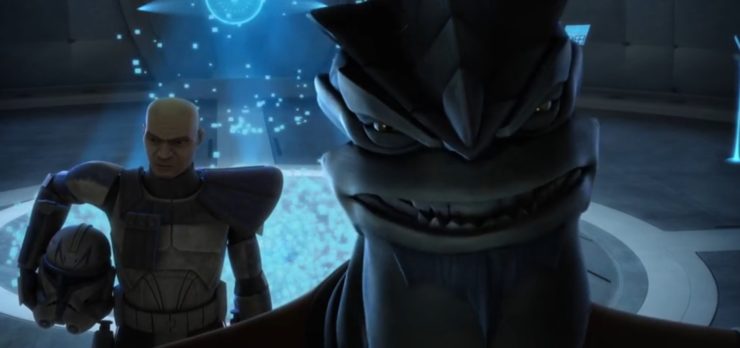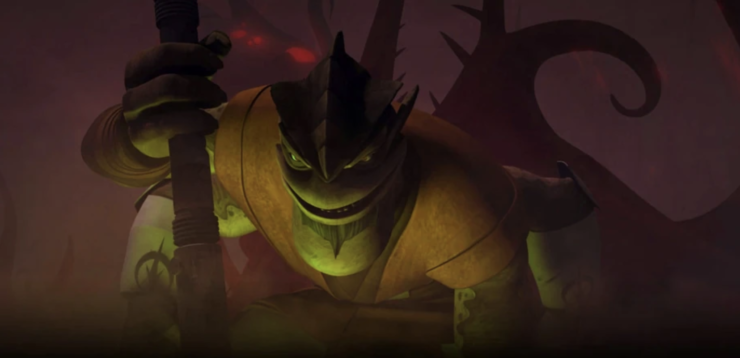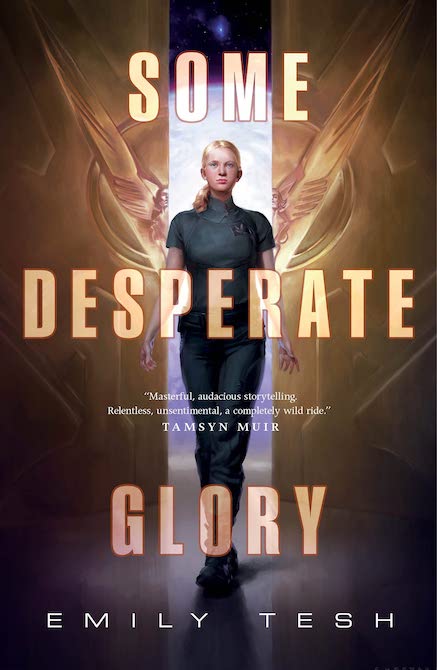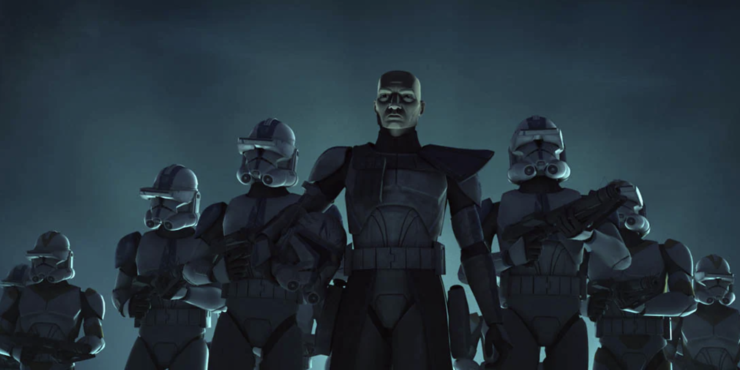Despite being a cultured, sophisticated film journalist/critic—the kind of person who when dining out resolutely eschews any use of dipping sauce for fear that it’ll mar the purity of the McNugget—I have to admit I’m not immune to going full fan-mode when the occasion arises. I became all schoolgirl giggly when I got the opportunity to interview special effects master Douglas Trumbull; when the PR people were giving me the “wrap it up” signal during my video session with Stan Lee, I came close to snapping, “No! This is my moment!”; when Star Trek: The Experience was still running in Las Vegas, there was I, grinning like a fool and thinking, I’m standing on the bridge of the Enterprise!
And, to be honest, I have a bit of a fan’s defensiveness when it comes to Star Wars.
Specifically: My reaction to what the franchise as a whole has become, in contrast to its very first entry, Star Wars Episode IV: A New Hope (or just Star Wars, as some even more hardcore fans will insist it be called). What hooked me when I saw the film on its debut night in 1977 was the whole giddy, mash-up nature of the exercise, mixing samurai epics with Flash Gordon serials with Hollywood swashbucklers, all goosed with keen production design and cutting-edge special effects. I kept coming into the follow-ups looking for the same rush, and encountering something different each time, from the operatic drama of The Empire Strikes Back to the noir tangents of Attack of the Clones, all the way to the “Life Within the Empire” structuring of Andor. Whatever my reaction to each specific work—be it positive or negative—there was always this teeny-tiny part of me that couldn’t help but feel just a little bit bugged. That part would behold these new takes and murmur—and I’m not proud to admit this—“Not my Star Wars.”
But then another part, the part that values a living cinema, would kick in, and I would realize how vital it was that Star Wars has grown and evolved over its near-half-century of existence. Not all of the variations have been successful (take your pick), but excluding some notable exceptions (once again, your call), the franchise has exhibited a heartening willingness to develop beyond its gee-whiz beginning. And one of the most encouraging modifications is how, over time, Star Wars has matured in its treatment of its legions of star warriors. Even before Finn (John Boyega) snatched off his stormtrooper helmet and made us realize, Holy shit, there are people in there!, the TV series, Star Wars: The Clone Wars (2008–2020) was giving us reasons to feel for the hitherto nameless soldiers who wielded the blaster rifles.
That hasn’t always been the case. Granted, the Star Wars franchise is not alone in propping up anonymous targets to mow down—last year’s The Batman extended its run time past its logical end point just so Robert Pattinson’s Dark Knight had an opportunity to subdue (non-lethally) a corps of nameless stooges. But Star Wars has been notable for all the ways it finds to create its various strawmen. There are the first prequel’s “comically” inept droid army, and the original’s stormtroopers. And then there are the Troopers’ predecessors, the clones, literally identical human beings bred for war, who fight for the Republic until an implant is triggered that compels them to exterminate the Jedi.
The prequel trilogy itself doesn’t do much with the clones. They show up at the end of Episode Two, and in Episode Three they fight the war and automatically commit their betrayal. It falls to Clone Wars, which is set in the time period between episodes two and three, to suggest that there may be more to the manufactured soldiers than just an ability to put their lives on the line for the powers that commissioned them. This is especially true of the 501st Legion, the battalion of clones who serve under General Anakin Skywalker. And who, in a quartet of episodes from the series’ fourth season, find themselves in a moral conflict between their ingrained commitment to military protocol and their innate understanding of their own humanity.

Across the four episodes—”Darkness on Umbara,” “The General,” “Plan of Dissent,” and “Carnage of Krell”—the 501st find themselves taken away from Skywalker’s charge and put under the command of the Besalisk Jedi Master Pong Krell (voiced marvelously by Dave Fennoy). Deployed on a mission to wrest the “shadow world” Umbara from Separatist control, the clones not only find themselves pitted against the native Umbarans who have formed an alliance with the Separatists, but also with Krell, a commander who willfully refuses to see past the soldiers’ lab-grown origins.
The first shock of these episodes is how unrelentingly dark they are. As noted, Star Wars is no stranger to shifting tones, but the franchise has never lost sight of its roots in mainstream cinema, and has tried not to stray too far from the constraints of action for entertainment’s sake. There are wars in Star Wars, but they’re wars that can be easily waged with action figures across a living room carpet, with the emotional consequences being just as impactful.
Not so here. From the moment they set foot on the eternally night-shrouded Umbara, the typically gung-ho 501st find themselves caught off-balance. There are echoes of the chaos of D-Day and the quagmire that was Vietnam—plus the gritty grunt’s-eye view of a soldier’s life as captured by legendary director Sam Fuller—in the treacherousness of the unfamiliar terrain, and the resistance put forward by the well-armed Umbarans, who command eerie, energy-ball-spewing battle pods and swift, creepy, centipede-like tanks. Particularly in the first two episodes, directors Steward Lee and Walter Murch turn the battle scenes into kinetic nightmares, with the mist-shrouded, oddly shaped flora highlighted in an ominous, bioluminescent red, and the warfare a morass of blue and green crossfire. And for all that any Star Wars battle will feature scores, if not hundreds of felled combatants, the deaths here are especially violent, and particularly disturbing. You are aware that lives are being lost. And it ain’t no fun.
According to Matt Michnovetz, the writer of these four episodes, the Vietnam analogy is no accident: “Film-wise, Apocalypse Now and Platoon were direct inspirations. We really just wanted to acknowledge the horror of war, tell a great story and give these characters the most emotional, life-changing experience we could for this arc.”
If only General Krell evinced a similar empathy. Turns out that the Clone Wars crew had a reason for portraying combat as graphically and disturbingly as the limits of “family-oriented” television would allow. It’s not just for shock value—although breaking the audience out of thinking of war as a fun adventure would be enough—it’s so the horror of the general’s actions could be cast in full relief.

It is observed among the clones that Krell is an especially effective commander, but also one notable for his high casualty rates. And indeed, the general’s strategy is simple, and simply abhorrent: Put as many soldiers into harm’s way as possible, and count on sheer numbers to overcome the enemy’s forces. There’s no moral question to be weighed, from Krell’s point of view: They’re clones—sacrifice a dozen, or a hundred, or a thousand, and you just have to send up a work order to the Kamino gestation plants for their replacements. That blunt regard of his soldiers as pure cannon fodder is reflected in how the General relates to those under his command: Any assertion of individuality or humanity is brusquely cast aside; any display of initiative is denigrated. Just the way Krell uses the word “clone” drips with contempt—it’s tantamount to a racial slur as it passes his lips.
The clones, of course, see things differently. They are individuals. They may share the same face, but their autonomy goes beyond distinctive haircuts, unique tattoos, and armor customization, all the way through to their attitudes toward warfare and the ways they view their world (and kudos to voice actor Dee Bradley Baker, who does a superlative job finding different “flavors” for essentially the same voice). We get that particularly in the members of the 501st, whose dedicated commander Rex finds himself in conflict with the younger and more skeptical Fives, the up-for-action Hardcase, and the strictly-by-the-book Dogma (yeah, well, nobody said the naming conventions had to be subtle).
But to a one, they are haunted by the conflict between their own humanity and their awareness of the purpose for which they were created. “We’re soldiers,” Rex tells Fives. “We have a duty to follow orders and, if we must, lay down our lives for victory.” To which Fives shoots back, “Do you believe that, or is that what you were engineered to think?” Rex responds, with an irony even he may not be aware of, “I honor my code.”
Buy the Book


Some Desperate Glory
And that’s the crux of the General Krell arc: the conflict between duty and individuality, between loyalty to a cause and loyalty to one’s fellow humans. All generals are burdened with the knowledge that they are putting lives not their own on the line; the difference between Anakin Skywalker, who leads his troops into battle and respects them as equals, and Pong Krell, who commands from behind and steadfastly—nay, contemptuously—refuses to recognize the clones as anything other property to be utilized and disposed of at will, is the difference between fully assuming the grim weight of warfare and imperiously shunting off responsibility for the lives lost. In the direst of situations, Krell will not accept the consequences of his decisions, and that makes him a danger to his troops, and to the cause of the Republic.
In my opinion, Clone Wars somewhat undercuts the power of these themes by revealing in the fourth episode that Krell has gone over to the Dark Side. Michnovetz begs to differ: “Originally, he was not motivated by the Dark Side, just his own ideology and drive to win. After a few rewrites, we felt it added more tension to the finale, making his motivation more clear, upping the stakes and helping drive the debate about whether he can fall into enemy hands.” I do get it: In the end, Star Wars gotta be Star Wars. But I feel something gets lost in transferring agency from Krell himself to an intangible incarnation of evil. By the time we get to that reveal, though, it may be beside the point. The General Krell arc may dwell within the universe of an action-adventure franchise, but its issues extend far beyond, cutting to what we owe to ourselves, to our society, and to each other.
* * *
In his responses, Matt Michnovetz gave credit to George Lucas for inspiring the General Krell arc, as well as to his colleagues, including Clone Wars executive producer Dave Filoni, for how those episodes turned out. Michnovetz has since gone on to serve as story editor for the clone-centric Star Wars: The Bad Batch, a recent episode of which, “The Solitary Clone,” contains echoes of the themes explored in the General Krell arc.
IMHO, Star Wars: The Clone Wars was never better than when it was examining the personal dynamics and motivations of the clones. The General Krell arc may be the pinnacle of those explorations, but you may feel there are other episodes that better delve into the hearts of the clones, or other reasons you were drawn to Clone Wars overall. If so, please avail yourself of the comments section below. But remember: There’s no higher ground here —please let the warfare be constrained to the action on the screen, and keep the conversation friendly and polite.
Dan Persons has been knocking about the genre media beat for, oh, a good handful of years, now. He’s presently house critic for the radio show Hour of the Wolf on WBAI 99.5FM in New York, and previously was editor of Cinefantastique and Animefantastique, as well as producer of news updates for The Monster Channel. He is also founder of Anime Philadelphia, a program to encourage theatrical screenings of Japanese animation. And you should taste his One Alarm Chili! Wow!










